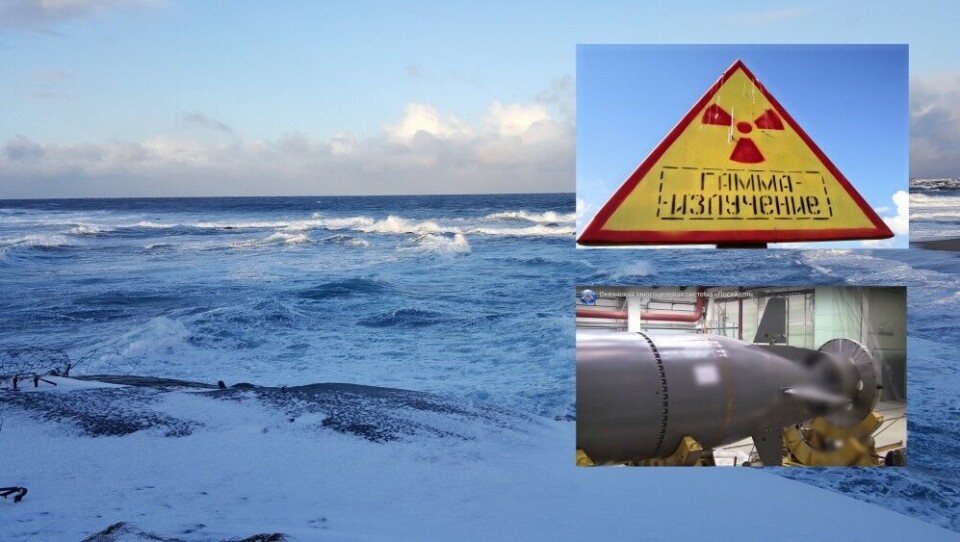
Russia to deploy 16 nuclear-powered doomsday drones on combat duty from Barents Sea
Moscow’s new scary class of nuclear weapons will be deployed from two submarines sailing for the Northern Fleet, each to carry a maximum of eight drones.
p.p1 {margin: 0.0px 0.0px 0.0px 0.0px; font: 11.0px Helvetica; color: #000000; -webkit-text-stroke: #000000}p.p2 {margin: 0.0px 0.0px 0.0px 0.0px; font: 11.0px Helvetica; color: #000000; -webkit-text-stroke: #000000; min-height: 13.0px}span.s1 {font-kerning: none}
The new weapons system has been rumored for a few years. Barents Observer first reported about the unmanned underwater torpedoes, described as a doomsday weapon, in December 2016.
In March last year, President Vladimir Putin was first to confirm the existence of the nuclear-powered drone, saying it could travel «extreme depths, intercontinentally, at a speed multiple times faster than the speed of submarines, cutting-edge torpedoes and all kinds of surface vessels, including some of the fastest.»
Putin was bragging about the capabilities of the new underwater weapon during his annual state-of-the-nation speech, saying it «is quiet, highly maneuverable and have hardly any vulnerabilities for the enemy to exploit.»
«There is simply nothing in the world capable of withstanding it,» Putin said with a proud, but serious voice.
Last summer, Russia’s Defense Ministry even published a video [see the end of this article] with a real versions of the torpedo, and Russian media were quick to tell that the weapon has been tested at «sites of the Defense Ministry» as reported by the Barents Observer.
Now, news agency TASS quotes a source in the military-industrial complex that the navy has plans to put up to 32 such underwater drones on combat duty, half with the Pacific Fleet and the other half with the Northern Fleet.
«It is assumed that the Poseidon [the name of the drone] will be carried by two submarines expected to enter service with the Northern Fleet and two will join the Pacific Fleet. Each of the submarines will carry a maximum of eight drones and, therefore, the total number of Poseidons on combat duty will reach 32 vehicles,» the source said.
If so, 16 nuclear-powered drones armed with a nuclear warhead will be stationed in the Barents Sea region. Russia’s European fleet of nuclear-powered submarines and sea-based nuclear weapons are all located from the Kola Bay and along the northwestern coast of the Kola Peninsula.
In Severodvinsk, the centre for all new-buildings of nuclear-powered submarines in Russia, two special purpose submarines are currently under construction, both believed to be carriers for the new giant drones. The «Khabarovsk» is a new 120 meter large submarine, while the «Belgorod» is a re-built Oscar-II class submarine.
How the system will work is still a bit unclear. Either the Poseidon drone will be brought to sub-sea installations by the named carriers and from those positions be ready to launch in case of war-alarm, or the Poseidons could be launched directly from the carrier subs.
A Poseidon would be able to carry a nuclear warhead with a size of up to two megatons. In Putin’s animation video, such drone was attacking an enemy navy aircraft carrier group. It could also target shore-side installations of cities.
The drone is powered by a mini-sized nuclear-reactor giving it nearly unlimited range and a speed said to be 200 km/h. p.p1 {margin: 0.0px 0.0px 0.0px 0.0px; font: 11.0px Helvetica; color: #000000; -webkit-text-stroke: #000000}span.s1 {font-kerning: none}
It has previously been reported that the drone can dive and move at a depth deeper than one kilometers. In comparison, most submarines can dive to a maximum of 400 to 600 meters.
On the Kola Peninsula, the Defense Ministry’s Main Directorate for Deep Sea Research, nicknamed GUGI, has a dedicated base for its fleet of special purpose nuclear-powered submarines in Olenya Bay, some 100 kilometers east of the border to Norway.
















